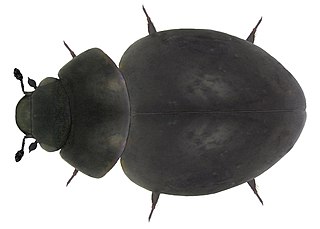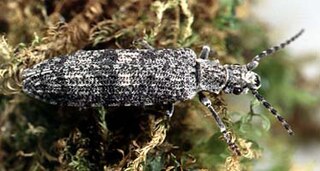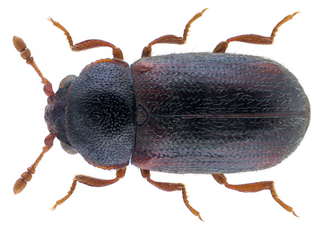
The telephone-pole beetle is a beetle native to the eastern United States, and the only living representative of the otherwise extinct family Micromalthidae. They have an unusual life cycle involving asexually reproducing (parthenogenetic) female larvae, as well as non-functional "ghost adults".

Sphaerius is a genus of beetles in the family Sphaeriusidae, comprising 18 species. It is one of the two extant genera in the family, the other being Bezesporum. They are typically found along the edges of streams and rivers, where they feed on algae; they occur on all continents except Antarctica. Three species occur in the United States.

Scydmaeninae are a subfamily of small beetles, commonly called ant-like stone beetles or scydmaenines. These beetles occur worldwide, and the subfamily includes some 4,500 species in about 80 genera. Established as a family, they were reduced in status to a subfamily of Staphylinidae in 2009

Myxophaga is the second-smallest suborder of the Coleoptera after Archostemata, consisting of roughly 65 species of small to minute beetles in four families. The members of this suborder are aquatic and semiaquatic, and feed on algae.

Priacma is a genus of beetles in the family Cupedidae. It contains a single extant species, Priacma serrata native to western North America and one fossil species, P. megapuncta from the Cenomanian aged Burmese amber. Species previously assigned to the genus from the Yixian Formation of China have been subsequently placed in the separate genus Apriacma.

The Ommatidae are a family of beetles in the suborder Archostemata. The Ommatidae are considered the extant beetle family that has most ancestral characteristics. There are only seven extant species, confined to Australia and South America. However, the geographical distribution was much wider during the Mesozoic spanning across Eurasia and Australia, suggesting that they were widespread on Pangea. So far, over 26 extinct genera containing over 170 species of these beetles have been described. Three extant genera have been assigned to this family: Omma,Tetraphalerus and Beutelius. The family is considered to be a subfamily of Cupedidae by some authors, but have been found to be more closely related to Micromalthidae in molecular phylogenies. A close relationship with Micromalthidae is supported by several morphological characters, including those of the mandibles and male genitalia. Due to their rarity, their ecology is obscure, it is likely that their larvae feed on deadwood.

Kateretidae also known as short-winged flower beetles are a family of beetles in the superfamily Cucujoidea. There are 10 extant and 4 extinct genera, and at least 40 described species. They are found worldwide except in New Zealand. Adults are anthophagous, feeding on flowers, while the larvae are spermatophagous inside the flower corolla.

Sphindidae is a family of beetles, in the suborder Polyphaga. They are called slime mold beetles due to their exclusive feeding on slime molds during adult and larval stages, other aspects of their life history are obscure. Palaeontological discoveries since 2015 have added to the geologic history of Sphindidae, including the discovery of Libanopsis, placed in the extinct subfamily Libanopsinae.

Helotidae is a family of beetles, in the suborder Polyphaga. The family includes about five extant genera, Helota MacLeay, Neohelota Ohta, Afrohelotina Kirejtshuk, Metahelotella Kirejtshuk, and Strophohelota Kirejtshuk. Helotidae are found mainly in the Old World tropics and are absent from Australia and Madagascar. The antennae are clubbed on the final three segments and is retractable within grooves under the head. The wings have reduced venation with just 4 anal veins. Helotids are known to be associated with sap, fruit and flowers, and the larvae of some species are known to bore into wood in order to pupate.

The Brachypsectridae are a family of beetles commonly known as the Texas beetles. There are only two extant genera, Brachypsectra and Asiopsectra. Brachypsectra has a cosmopolitan distribution, mostly in arid regions, while Asiopsectra is found in Central Asia and the Middle East.

Gyrininae is a subfamily of ground and water beetles in the family Gyrinidae. There are at least 740 described extant species in Gyrininae.

Throscidae is a family of elateroid beetles found worldwide with around 150 species in 5 extant genera. The larvae are soil-dwelling, siphoning fluid from mycorrhizae attached to trees. The adults are short-lived, with the adult males being noted for a complex mating dance. Like some other elateroids, they are capable of clicking.
2018 in paleoentomology is a list of new fossil insect taxa that were described during the year 2018, as well as other significant discoveries and events related to paleoentomology that were scheduled to occur during the year.
2019 in paleoentomology is a list of new fossil insect taxa that were described during the year 2019, as well as other significant discoveries and events related to paleoentomology that were scheduled to occur during the year.
2017 in paleoentomology is a list of new fossil insect taxa that were described during the year 2017, as well as other significant discoveries and events related to paleoentomology that were scheduled to occur during the year.
2020 in paleoentomology is a list of new fossil insect taxa that were described during the year 2020, as well as other significant discoveries and events related to paleoentomology that were scheduled to occur during the year.
2015 in paleoentomology is a list of new fossil insect taxa that were described during the year 2016, as well as other significant discoveries and events related to paleoentomology that were scheduled to occur during the year.

Bukhkalius is an extinct genus of beetle belonging to the family Ommatidae, it contains the single species, Bukhkalius lindae. It was described in 2017 initially as a species of the extant genus Tetraphalerus and was placed into a separate monotypic genus in 2020, which was reaffirmed in a 2021 study. It is known from a single specimen from Burmese amber, dating to the Cenomanian stage of the Late Cretaceous. The specimen is around 4.7 mm long and around 1.3 mm wide.
Burmese amber is fossil resin dating to the early Late Cretaceous Cenomanian age recovered from deposits in the Hukawng Valley of northern Myanmar. It is known for being one of the most diverse Cretaceous age amber paleobiotas, containing rich arthropod fossils, along with uncommon vertebrate fossils and even rare marine inclusions. A mostly complete list of all taxa described up until 2018 can be found in Ross 2018; its supplement Ross 2019b covers most of 2019.
Lepidomma is an extinct genus of ommatid beetle. The genus was first described in 2019 for the species L. tianae. Lepidomma was synonymised with Clessidromma by Kirejtshuk, 2020. This synonymy was disputed by Li et al. (2021), who maintained Lepidomma as a separate genus from Clessidromma. Three additional species of Lepidomma were described in 2020 and 2022. All four species are known from the Cenomanian aged Burmese amber of Myanmar.













